![]()
![]()
![]()
Use LEFT and RIGHT arrow keys to navigate between flashcards;
Use UP and DOWN arrow keys to flip the card;
H to show hint;
A reads text to speech;
46 Cards in this Set
- Front
- Back
|
Cause of malakopakia in respiratory tract?
|
Rhodococcus equi
|
|
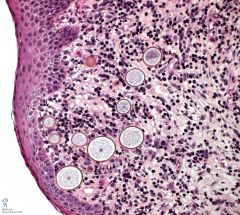
India, sri lanka, brazil
|
rhinosporidiosis
rhinosporidium sebri squamous hyperplasia |
|
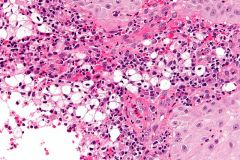
3rd world chronic granulomatous bacterial disease of the nose
Dx? cause? name for the foamy histiocytes? |
Rhinoscleroma
Klebsiella rhinoscleromatis Mikulicz cells |
|
|
foreign body-type granulomatous reaction to lipid-containing material and blood (or classically from nasal drops in the nose)
|
Myospherulosis
|
|
|
Hemangiopericytoma of the sinonasal type is negative for what classic HPC marker?
px? |
CD34-
+ for muscle markers WHO calls this glomangiopericytoma; also called myopericytoma Good px |
|
|
Sinonasal angiofibroma occurs in what patient population?
|
young men only
testosterone receptors |
|
|
sinonasal inverted papillomas arise from?
|
lateral wall
10% malignancy |
|
|
3 types of schneiderian papillomas?
|
inverted
septal cylindrical |
|
|
HIV associated lymphomas
|
Burkitt
DLBCL PEL Plasmablastic lymphoma oral cavity |
|
|
Sinonasal undifferentiated adenocarcinoma patient population
|
Woodworkers and leather workers
|
|
|
laryngeal papillomatosis HPV types
|
6,11
very rare to get malignancy from this |
|
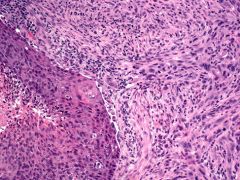
vocal cord lesion
cytokeratin negative |
spindle cell SCC - can be Ck negative!
looks sarcomatoid |
|
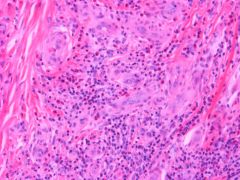
red bumps around the ear
|
angiolymphoid hyperplasia
young adults periaural plump endothelium EOS! and dense lymphohistiocytic infiltration with giant cells |
|
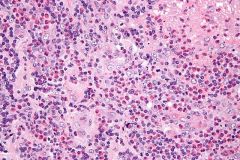
asian male
lymphadenopathy & peripheral eosinophilia warthin-finkeldey cells! |
kimura disease
|
|

external auditory canal tumor
|
ceruminous adenoma
apocrine cells & myoeps |
|
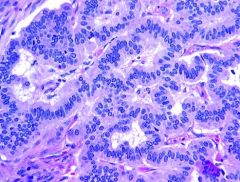
middle ear tumor
+ neuroendocrine markers |
middle ear adenoma
looks like carcinoid |
|
|
glomus tumor
|
paraganglioma
|
|
|
heffner tumor
associated with what syndrome? |
endolymphatic sinus tumor
looks like papillary thyroid ca papillary benign but must entirely excise PAS+ colloid-like material + cytokeratins VHL syndrome |
|
|
Schwannoms in CPA angle. what syndrome?
|
= acoustic neuroma
= neurilemmoma NF2! chrom 22 |
|
|
tyrosine crystals in salivary gland mean?
|
nothing
can be seen in both benign and malignant lesions |
|
|
ckit + salivary gland tumor
|
adenoid cystic carcinoma
has "gumballs" of basement membrane on cyto |
|
|
stains in myoepithelioma
|
S100
SMA GFAP!! |
|
|
what salivary tumor mimics cribiform DCIS and who gets it
|
salivary duct carcinoma
more common in males! Her2neu overexpression! |
|
|
IHC chordoma
|
+ PAS, CK, S100, EMA, mucin
cranial in younger patients |
|
|
polypoid mass ANTERIOR vocal cord
posterior? |
spindle cell SCC
contact ulcers |
|
|
what type of nasopharyngeal carcinoma is the most common, is associated with EBV, and has the best prognosis?
|
undifferentiated/nonkeratinizing type
|
|
|
#1 salivary gland tumor overall?
|
pleomorphic adenoma
|
|
|
#1 malignant salivary gland tumor in adults?
kids? |
1. mucoepidermoid carcinoma
2. Adenocarcinoma, NOS 3. acinic cell carcinoma 1. mucoepidermoid carcinoma 2. acinic cell carcinoma |
|
|
#1 malignant salivary gland tumor that is bilateral?
|
Acinic cell carcinoma
|
|
|
#1 malignant salivary gland tumor in minor salivary glands?
|
PLGA
(though some say adenoid cystic (ASCP)...) |
|
|
4 cell types of mucoep
|
mucin-producing, squamous, intermediate, and clear
|
|
|
Which syndrome is most strongly associated with membranous basal cell adenomas?
|
Brooke-Spiegler syndrome
autosomal dominant disease characterized by the development of numerous skin adnexal tumors such as spiradenomas, trichoepitheliomas, and cylindromas, in addition to membranous basal cell adenomas of the salivary glands. |
|
|
Which immunohistochemical stain is most helpful in differentiating a canalicular adenoma from a myoepithelioma or epithelial-myoepithelial carcinoma?
|
MSA (or any myoep marker)
Canalicular adenomas are negative for muscle-specific actin, which is indicative of the lack of myoepithelial differentiation in these lesions. Cytokeratin and S100 would be positive in all 3 of these tumors. |
|
|
What is this stain used for : Phosphotungstic acid-hematoxylin (PTAH)?
|
Oncocytoma
strong affinity for mitochondria. As such, the cytoplasm of mitochondria-rich oncocytic cells will stain dark blue, helping to confirm the diagnosis. |
|
|
Where do salivary duct carcinomas occur?
|
85% parotid
M>>F 40% 5-year survival |
|
|
how many PAs become Carcinoma ex PAs?
|
2% at 5y, 10% at 15y
only the epithelial component becomes malignant The carcinomatous element in these malignancies always arises from the epithelial component of the pleomorphic adenoma. Perineural and vascular invasion are frequently present |
|
|
Which architectural pattern of basal cell adenoma has the worst prognosis?
|
membranous (25% malignant transformation)
(this is the JIGSAW puzzle type, and are more often multifocal and lack a capsule) Other types are: Solid, Trabecular, Trabecular-tubular, Tubular |
|
|
#1 site for canalicular adenoma?
|
upper lip
|
|
|
causes of granulomatous thyroiditis
|
De Quervian's / subacute
Tb Sarcoid Palpation Mycosis |
|
|
Which immunohistochemical stain will likely be negative in adrenal cortical carcinomas?
|
chromogranin A
|
|
|
good prognostic factors in neuroblastoma
|
age < 1 yr
Trk mutation hyperdiploidy extra-adrenal location lymphs S100+ **LN status does NOT MATTER! |
|
|
poor prognostic factors in neuroblastoma
|
n-myc amplification
diploidy age > 1 abn chrom 1 increased levels of: NSE, LDH, chromogranin, ferritin, CKBB decreased ratio VMA:HVA |
|
|
% of FAMILIAL pheos that are bilateral?
|
50%
(the 10% rule applies to pheos overall!) |
|
|
Syndromes with pheos
|
MEN type II
von Hippel-Lindau disease Von Recklinghausen disease Sturge-Weber syndrome |
|
|
Which variant of paraganglioma has the highest rate of malignancy?
|
intraabdominal (extraadrenal) paraganglioma
20-50% |
|
|
IHC neuroblastoma
|
+ NSE, norepi, chromogranin A, synaptophysin and neurofilament proteins
- for epinephrine! |

